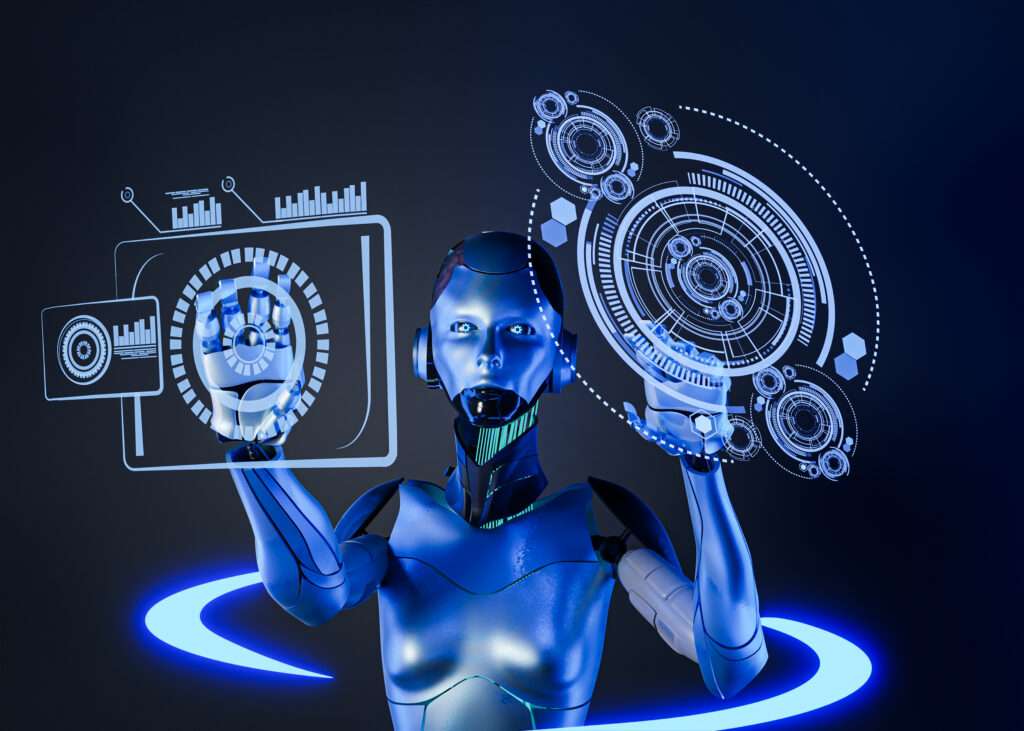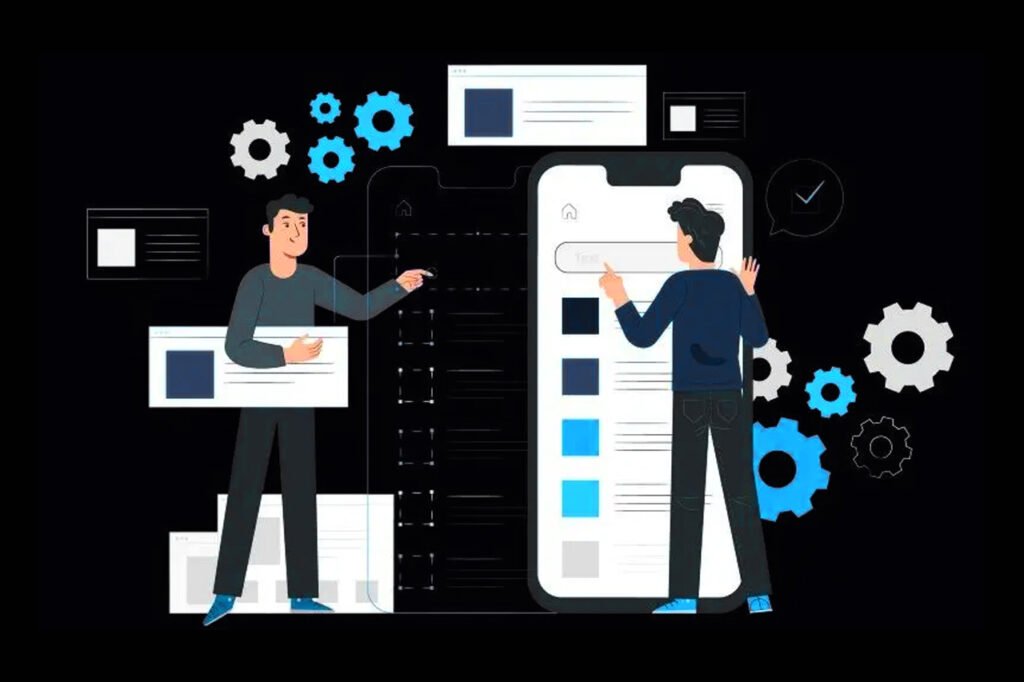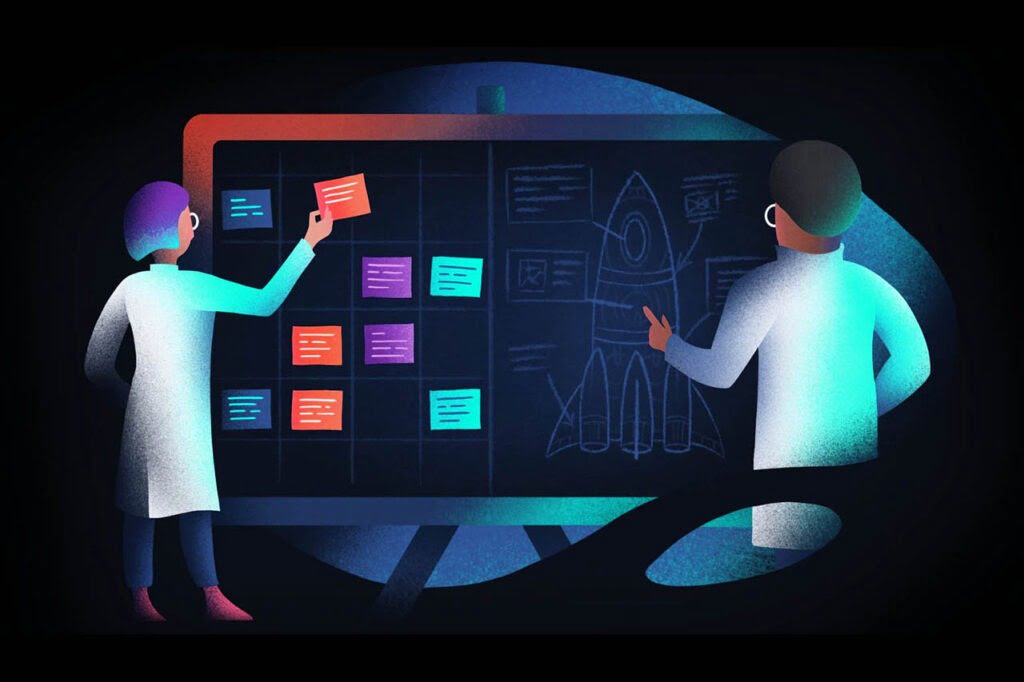AI in Drug Discovery – Drug Development Simplified and Explained
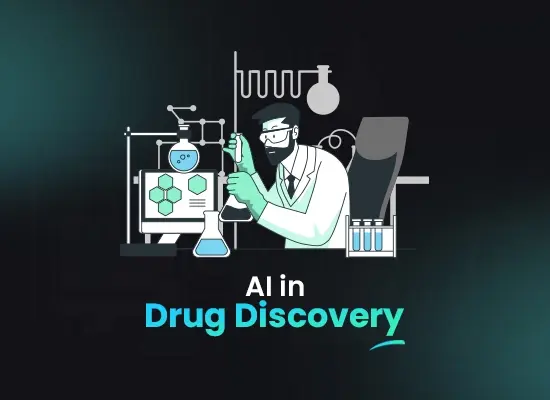
AI in Drug Discovery or Drug development is a notoriously slow and expensive process, but artificial intelligence (AI) is rapidly changing the game. By analysing vast datasets and employing advanced algorithms, AI is transforming drug discovery, offering new avenues for identifying potential medications, optimising their design, and accelerating the entire development pipeline. This holds immense promise for bringing new and effective treatments to patients faster and at a lower cost.
What is the Role of AI in Drug Discovery?
Drug development has traditionally been a slow and expensive process, riddled with trial and error. It can take years, and billions of dollars, to bring a new drug to market, with a high chance of failure at each stage. This is where AI in drug discovery is making a significant impact.
Artificial Intelligence (AI), is transforming the way we discover and develop new medications. By leveraging vast datasets, machine learning algorithms, and powerful computing, AI in drug discovery is accelerating the process like never before. AI can analyse mountains of biological and chemical data to identify promising drug targets, those molecules involved in disease processes. This allows researchers to focus their efforts on these targets, increasing the success rate of development of drugs.
One of the key areas where AI development is having a major impact is in AI drug design. Traditionally, designing new drugs has been a laborious process involving synthesising and testing countless molecules. AI can now predict how a molecule will interact with a target, allowing researchers to virtually design drugs with the desired properties. This significantly reduces the need for automated drug testing, a slow and resource-intensive process.
The potential benefits of AI in drug discovery extend far beyond efficiency and cost savings. AI can be used to identify new types of drugs, predict potential side effects, and even personalise treatments for individual patients. This is particularly important in the field of pandemic prevention solutions. By rapidly identifying and developing drugs against new and emerging pathogens, AI can play a crucial role in combating future pandemics.
In conclusion, AI in drug discovery is revolutionising the way we develop new medicines. From identifying promising drug targets to designing new drugs and predicting potential side effects, AI is accelerating the process and increasing the chances of success. As AI continues to evolve, its impact on drug discovery will only become more profound, leading to the development of life-saving treatments for a wide range of diseases and paving the way for a healthier future.
Seamless Collaboration | Cost-Efficient Solutions | Faster Time-to-Market

Why Do We Need AI in Drug Discovery for Drug Development?
Development of drugs is a notoriously slow and expensive process. Traditionally, it can take a decade or longer and cost billions of dollars to bring a new drug to market. This lengthy timeline is a significant hurdle, particularly when faced with urgent public health needs like emerging infectious diseases. Here’s where AI in drug discovery steps in, offering a powerful set of tools to streamline and accelerate this critical process.
AI in drug discovery utilises AI and machine learning development to analyse vast amounts of biological data. This data can include everything from protein structures and gene sequences to patient medical records. By sifting through this complex information, AI can identify potential drug targets, molecules that play a key role in disease processes. This allows researchers to focus their efforts on developing drugs that are more likely to be effective.
Once a potential drug target is identified, AI drug design can then be used to create new drug candidates. AI algorithms can analyse the structure of the target molecule and predict how different small molecules might interact with it. This allows researchers to virtually test millions of compounds in a fraction of the time it would take to do so in a lab. This not only speeds up the process but also reduces the cost of development of drugs.
Automated drug testing is another area where AI is making a significant impact. AI-powered systems can analyse the results of laboratory experiments and clinical trials, identifying patterns that might not be obvious to human researchers. This can help to identify promising drug candidates earlier in the development process and eliminate those that are less likely to be successful.
The potential benefits of AI in drug discovery extend far beyond traditional drug development. In the fight against pandemics, AI-powered tools can be used to rapidly identify and develop new treatments and vaccines. By accelerating the drug development timeline, AI can help to mitigate the spread of infectious diseases and save countless lives.
In conclusion, AI in drug discovery is transforming the way we develop new drugs. From identifying promising drug targets to designing new drug candidates and automating drug testing, AI is offering a powerful set of tools to streamline this critical process. This not only holds the promise of faster and more cost-effective development of drugs but also offers valuable tools for pandemic prevention solutions.
Benefits of AI in Drug Development:
The traditional process of drug development is a slow and expensive endeavour. It can take well over a decade and billions of dollars to bring a single new medication to market. However, the field of artificial intelligence (AI) is revolutionising drug development, offering a powerful set of tools to streamline the process and accelerate the discovery of life-saving treatments. Here are 8 key benefits of AI in development of drug:
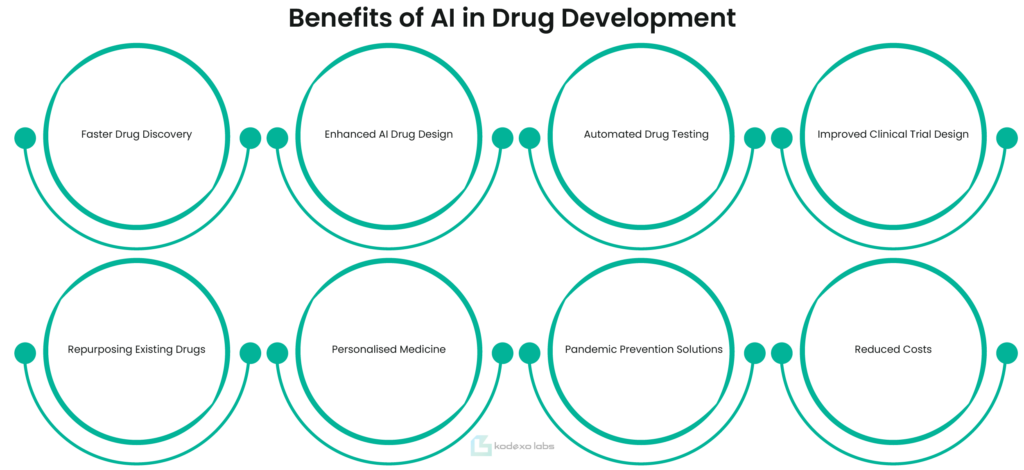
1- Faster Drug Discovery:
AI excels at analysing vast datasets of scientific information. In AI-based drug discovery, researchers can leverage this ability to identify potential drug targets, simulate molecular interactions, and predict the effectiveness of candidate compounds. This significantly reduces the time it takes to identify promising leads, propelling them towards further testing.
2- Enhanced AI Drug Design:
AI algorithms can be trained on vast libraries of existing drugs and their properties. This allows them to virtually design new drug molecules with specific characteristics, tailoring them to target particular diseases or improve upon existing medications. This capability, known as AI drug design, offers a more efficient and targeted approach to drug development.
3- Automated Drug Testing:
A significant bottleneck in drug development is the laborious process of pre-clinical testing. AI can automate many aspects of this phase, including analysing data from high-throughput screening and predicting potential side effects. This not only reduces costs but also allows researchers to test a wider range of drug candidates more quickly.
4- Improved Clinical Trial Design:
AI can analyse patient data and medical records to identify suitable participants for clinical trials. This ensures that trials are more efficient and statistically robust, leading to more reliable results. Additionally, AI can be used to optimise clinical trial design by predicting patient responses and tailoring treatment regimens.
5- Repurposing Existing Drugs:
AI can analyse vast datasets of existing drugs and their effects to identify new applications for them. This process, known as drug repurposing, can significantly reduce the time and cost associated with bringing new treatments to market, especially for diseases with unmet medical needs.
6- Personalised Medicine:
AI can analyse a patient’s unique genetic makeup and medical history to predict how they might respond to different medications. This personalised approach to drug treatment can lead to more effective and targeted therapies with fewer side effects.
7- Pandemic Prevention Solutions:
The COVID-19 pandemic highlighted the urgent need for rapid response in developing vaccines and treatments for emerging infectious diseases. AI can be instrumental in this fight by analysing viral sequences and protein structures to identify potential drug targets and expedite the development of effective countermeasures.
8- Reduced Costs:
By streamlining various aspects of development of drug, AI has the potential to significantly reduce overall costs. This not only benefits pharmaceutical companies but also makes new treatments more accessible to patients around the world.
In conclusion, AI is transforming the landscape of development of drug. From accelerating drug discovery to personalising treatment plans, AI offers a multitude of benefits that have the potential to revolutionise healthcare and improve patient outcomes. As AI technology continues to evolve, we can expect even greater advancements in the field of development of drug, leading to the creation of life-saving treatments faster and more efficiently than ever before.
What is the Role of Machine Learning (ML) in Automated Drug Testing?
The field of drug development is undergoing a revolution with the integration of artificial intelligence (AI), particularly machine learning (ML). ML algorithms are playing a crucial role in automation in drug testing, streamlining the process of identifying and testing potential drug candidates. This automation is significantly accelerating drug discovery, leading to the faster development of new medications for a variety of diseases.
AI in drug discovery utilises machine learning models to analyse vast datasets of chemical compounds, biological information, and historical drug testing results. These models can then predict the properties and potential effectiveness of new drug candidates. By virtually screening millions of compounds, automated drug testing powered by ML allows researchers to prioritise the most promising candidates for further investigation. This significantly reduces the time and resources needed in traditional development of drug, where countless compounds are tested in a trial-and-error approach.
The impact of ML in automation in drug testing extends beyond efficiency. Machine learning can identify patterns and relationships in complex datasets that may be missed by human researchers. This can lead to the discovery of novel drug targets and the development of more effective medications with fewer side effects. This is particularly significant in areas like pandemic prevention solutions, where rapid development of vaccines and treatments is critical.
In conclusion, machine learning is fundamentally changing the landscape of development of drug. Automated drug testing powered by Machine Learning development is accelerating the discovery of new medications, while also leading to more targeted and effective treatments. As AI and machine learning continue to evolve, we can expect even greater breakthroughs in drug discovery, paving the way for a healthier future.
What are the Uses of Generative AI in AI Drug Design?
The traditional drug development process is notoriously slow and expensive. It can take years, and billions of dollars, to bring a single drug from initial discovery to market. AI in drug discovery has emerged as a powerful tool to streamline this process, and generative AI is at the forefront of this revolution.
Generative AI essentially uses algorithms to learn from existing data and then generate entirely new data, in the case of AI drug design, this translates to creating novel drug candidates with specific properties. This allows researchers to virtually explore a vast chemical space, identifying potential drug leads that would be nearly impossible to find through traditional methods.
One of the key uses of generative AI development in AI drug design is accelerating the identification of promising drug candidates. By generating vast libraries of virtual compounds, generative AI can significantly reduce the time it takes to identify molecules with the desired properties for a particular disease target. This allows researchers to prioritise the most promising candidates for further testing, significantly speeding up the overall development of drug timeline.
Furthermore, generative AI integration can be used for automation in drug testing. By predicting how these AI-generated molecules might interact with biological systems, researchers can virtually assess their efficacy and potential side effects. This not only reduces the need for expensive and time-consuming laboratory testing but also allows for a more targeted approach to drug development.
The potential applications of generative AI in AI drug design extend far beyond traditional drug development. For example, generative AI can be used to identify new uses for existing drugs, a process known as drug repurposing. This is particularly valuable in the context of pandemic prevention solutions. By identifying existing drugs that could be effective against new pathogens, generative AI can help to expedite the development of treatments during outbreaks.
Overall, generative AI is playing a transformative role in AI drug design. By accelerating the identification of promising drug leads, optimising existing drugs, and even aiding in pandemic prevention solutions, generative AI holds immense promise for the future of medicine.
How Does Deep Learning (DL) Affect Drug Development?
Drug development is a notoriously slow and expensive process. Traditionally, it can take well over a decade and billions of dollars to bring a new drug to market. This is due to the complex nature of diseases and the need for rigorous testing to ensure safety and efficacy. However, recent advancements in Deep Learning (DL) are revolutionising the field of drug discovery, offering significant promise for accelerating the development of new therapies.
DL, a subfield of Artificial Intelligence (AI), uses powerful algorithms inspired by the structure and function of the brain. These algorithms can analyse vast amounts of complex data, such as chemical structures, biological information, and patient data. This allows them to identify patterns and relationships that might be missed by traditional methods. In the context of drug discovery, DL is being applied in several key areas:
1. Target Identification:
DL can analyse biological data to identify potential targets for new drugs. These targets could be proteins or other molecules involved in disease processes.
2. Drug Design:
Once a target is identified, DL can be used to design new drug molecules that are likely to interact with the target and have the desired therapeutic effect.
3. Predicting Efficacy And Safety:
DL models can be trained on data from clinical trials to predict how well a new drug is likely to work and what side effects it might cause.
Why Do We Need to use Neural Networks in Automated Drug Testing?
Automated drug testing has become increasingly important for various applications, including workplace safety testing, sports anti-doping, and clinical trials. While traditional methods are reliable, they can be time-consuming and require specialised personnel. This is where Neural Network (NN) comes in, offering a powerful tool to enhance the efficiency and accuracy of automated drug testing.
Neural networks are a type of artificial intelligence inspired by the structure and function of the human brain. They consist of interconnected nodes, mimicking neurons, that process information and learn from patterns. In automated drug testing, NNs can be trained on massive datasets of chemical profiles associated with various drugs. This training allows them to identify subtle patterns in the data that might be missed by traditional methods. There are several key reasons why Neural Networks are becoming essential for automated drug testing:

1. Enhanced Accuracy:
NNs can learn complex relationships between chemical structures and their corresponding drugs. This allows them to detect a wider range of substances, even those with novel chemical modifications designed to evade detection.
2. Reduced False Positives:
Traditional testing methods can sometimes produce false positives, which can be inconvenient and costly. NNs can be fine-tuned to minimise false positives by recognizing specific patterns associated with legitimate medications or dietary supplements.
3. Improved Efficiency:
Neural networks can analyse large amounts of data through data analytics very quickly, significantly reducing the time it takes to process samples. This can be crucial in situations where rapid results are needed, such as in workplace safety testing.
4. Continuous Learning:
Unlike traditional methods, NNs can continuously learn and improve as they are exposed to new data. This allows them to stay up-to-date with the latest trends in drug development and identify emerging threats.
In conclusion, Neural Networks offer a powerful and versatile tool for automated drug testing. Their ability to learn complex patterns, improve accuracy, and streamline the testing process makes them a valuable asset in ensuring safety and compliance across various fields. As research in this area continues, we can expect NNs to play an even greater role in the future of automated drug testing.
Seamless Collaboration | Cost-Efficient Solutions | Faster Time-to-Market

What are the Uses of AI Drug Design?
Drug discovery has traditionally been a slow and expensive process, riddled with trial and error. However, Artificial Intelligence (AI) is rapidly transforming this field by offering a powerful set of tools. Let’s delve into seven key ways AI is being utilised in drug design:

1- Target Identification and Prioritization:
AI can analyse vast datasets of biological information to identify promising drug targets – molecules involved in disease processes. By pinpointing the most relevant targets, researchers can focus their efforts on developing drugs with a higher chance of success.
2- Virtual Screening of Drug Candidates:
Imagine sifting through millions of potential drug molecules! AI algorithms can perform virtual screening, analysing vast chemical libraries to identify molecules with the desired properties for binding to a specific target. This significantly reduces the time and resources needed compared to traditional screening methods.
3- De Novo Drug Design:
This exciting application involves AI generating entirely new drug candidate structures from scratch. By learning from known drugs and their interactions with targets, AI models can propose novel drug designs with optimised properties.
4- Predicting Drug Properties:
AI can analyse the structure of a potential drug molecule and predict its key properties, such as absorption, distribution, metabolism, excretion, and toxicity (ADMET). This helps researchers identify molecules with favourable drug-like characteristics early in the development process.
5- Optimising Lead Molecules:
Once a promising lead molecule is identified, AI can be used to refine its structure to improve its potency, selectivity, and overall efficacy. By analysing how changes in the molecule’s structure affect its properties, researchers can optimise lead molecules for better performance.
6- Repurposing Existing Drugs:
AI can analyse vast datasets of existing drugs and their effects on different diseases. This allows researchers to identify drugs that might be effective for new uses, accelerating the development process for repurposed drugs.
7- Reducing Animal Testing:
While not a complete replacement, AI models can be used to predict a drug’s safety and efficacy, potentially reducing the reliance on animal testing in preclinical stages. This can not only streamline the development process but also raise ethical considerations.
These are just some of the ways AI is transforming drug design. As AI technology continues to evolve, we can expect even more powerful applications to emerge, leading to the development of safer, more effective drugs and ultimately, improved patient outcomes.

Author Bio
Syed Ali Hasan Shah, a content writer at Kodexo Labs with knowledge of data science, cloud computing, AI, machine learning, and cyber security. In an effort to increase awareness of AI’s potential, his engrossing and educational content clarifies technical challenges for a variety of audiences, especially business owners.
